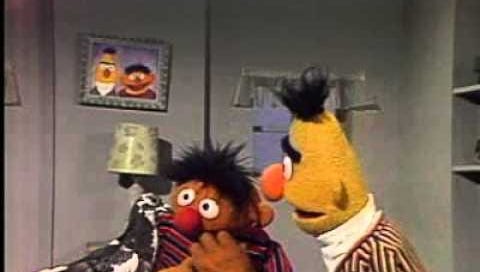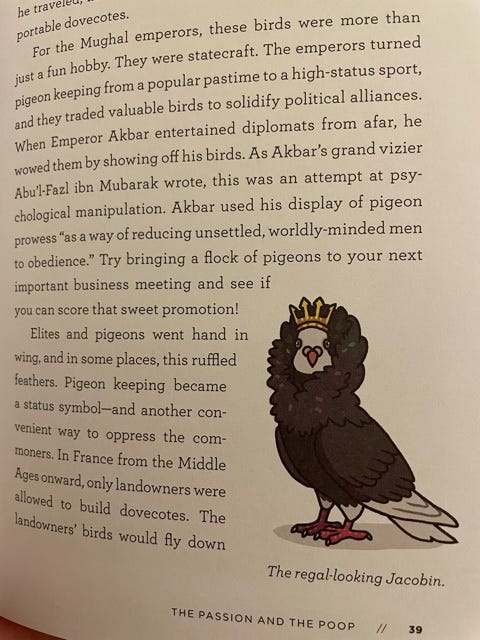I was sick this past week, so I just wanted to do a quick post to say what a delightful time I’m having reading Rosemary Mosco’s A Pocket Guide to Pigeon Watching: Getting to Know the World's Most Misunderstood Bird.
Like Bert, I’ve always been a bit of a pigeon fancier — after all, who could possibly fail to be beguiled by the iridescent green/purple shine of a pigeon neck? Or their calming cooing?
But until now, I’ve never known about Cher Ami, Pigeon Heroine of World War I whose desperate flight rescued a U.S. battalion trapped behind enemy lines. She delivered her message despite terrible injuries to her leg and breast, and the Lost Battalion were rescued. For her bravery, Cher Ami was awarded the Croix de Guerre, one of France’s highest military honors.
(I realize the Smithsonian lists Cher Ami as a male bird; apparently there was some confusion due to Cher Ami’s name, which is apparently a masculine name in French. The bird, however, was female, which has led to a great deal of confusion over time.)
Nor did I know that pigeons could come embellished with their own haute couture feathered hoods.
Mosco points out that basically all pigeons we see today are derived from pigeons bred to live with humans. They were once extremely useful domesticated animals. We kept them for their meat, for their poop (which was excellent fertilizer before chemical fertilizer was invented), and also for vast networks of pigeon communication. And then, all of a sudden, pigeons weren’t useful any more.
Now, they’re yesterday’s technology, but centuries of domestication means they can’t shake the human habit. Once cliff-dwellers, now they prefer skyscrapers. Humans often think of pigeons as “rats with wings” — a line popularized, as I learned in Mosco’s book, by Woody Allen’s Stardust Memories — but they’re really more pet than vermin.
(And even rats … well, I’ll get into that another time. Suffice it to say that DC and New York are both fighting their own wars with rats and it’s made me kind of interested in finding out more about the history of humans & rats. I’m thinking about picking up Rats: Observations on the History & Habitat of the City's Most Unwanted Inhabitants, but let me know if you have any other recommendations.)
(Another parenthetical to say that I adore this Goodreads review of the Rats: Observations book by someone named Jessica that goes into Jessica’s extensive childhood history of having friends with pet rats:
Okay, so when I was in the first grade, my across-the-street frenemy Lindsay Kagawa had a pet rat named Twinkie. Twinkie was what this book taught me is called a "fancy rat." She was little and delicate and black and white, and she lived in a cage in Lindsay's room. Lindsay and I both loved her rat, and we'd write letters to one another every day, letters that featured drawings of Twinkie engaged in a number of activities (e.g., getting married, doing ballet, holding balloons), letters that were hand delivered into mailboxes and adorned with pencil-drawn stamps featuring portraits of -- who else? -- Twinkie the rat.)
At any rate, I hope to write about rats sometime soon. But in the meantime, pigeons! I am loving pigeons. And I hope you are too. Even if they’re not quite smart enough to win every game of checkers, they’re pretty amazing birds.






I always liked Bert and his pigeons.
Great topics! I love pigeons and rats and Rosemary Mosco. (The first we featured in our own newsletter early on, the second I had as pets myself for several years, and the third, well, she's just awesome.) I recently read in an online forum that a number of cities in Europe have been changing strategies when it comes to pigeon overpopulation, and building lofts where they provide the pigeons with nutritious food and then swap out the eggs they lay with fakes. Apparently it leads to happier, healthier pigeons who don't crowd the streets looking for handouts, and whose population will slowly decrease over time.